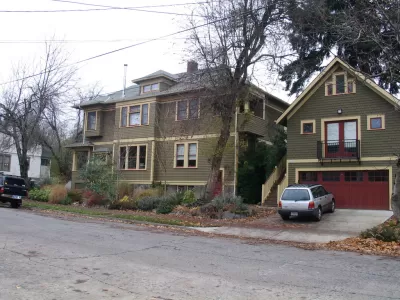They're a good start. But compared to similar policies in cities like Portland and Vancouver, Seattle's new policies around accessory dwelling units may be lackluster.

Earlier this month, Natalie Bicknell writes, Seattle released an environmental impact statement proposing the removal of code barriers to the construction of accessory dwelling units (ADUs) and detached dwelling units (DADUs). "The EIS also proposed size restrictions on construction of new single-family homes. Taken together, the two measures are intended to increase and preserve affordable housing stock throughout the city."
While the measure improves on the city's current policies, Bicknell says it does not favorably compare "to Portland's Residential Infill Project, or the more liberal ADU policies of Vancouver." She cites Dan Bertolet's point-by-point rundown of the Seattle plan's strengths and weaknesses, which include a wild card: a so-called "McMansion ban" on new homes that occupy too much of their lots.
Under the new rules, "new homes could be constructed at a maximum of 2,500 square feet or a floor-area ratio of 0.5, or no more the half the square footage of the lot. Considering that in 2018 the average size of a new single-family home in US is 2,641 square feet, with many new homes exceeding that size, the restriction does represent an improvement."
Portland's size restrictions went further, however, also legalizing housing types like duplexes and corner lot duplexes. In other words, missing middle housing.
See also: Portland Makes ADU Incentives Permanent
FULL STORY: Seattle’s Backyard Cottage Plan Falls Short

Alabama: Trump Terminates Settlements for Black Communities Harmed By Raw Sewage
Trump deemed the landmark civil rights agreement “illegal DEI and environmental justice policy.”

Planetizen Federal Action Tracker
A weekly monitor of how Trump’s orders and actions are impacting planners and planning in America.

Why Should We Subsidize Public Transportation?
Many public transit agencies face financial stress due to rising costs, declining fare revenue, and declining subsidies. Transit advocates must provide a strong business case for increasing public transit funding.

Understanding Road Diets
An explainer from Momentum highlights the advantages of reducing vehicle lanes in favor of more bike, transit, and pedestrian infrastructure.

New California Law Regulates Warehouse Pollution
A new law tightens building and emissions regulations for large distribution warehouses to mitigate air pollution and traffic in surrounding communities.

Phoenix Announces Opening Date for Light Rail Extension
The South Central extension will connect South Phoenix to downtown and other major hubs starting on June 7.
Urban Design for Planners 1: Software Tools
This six-course series explores essential urban design concepts using open source software and equips planners with the tools they need to participate fully in the urban design process.
Planning for Universal Design
Learn the tools for implementing Universal Design in planning regulations.
Caltrans
Smith Gee Studio
Institute for Housing and Urban Development Studies (IHS)
City of Grandview
Harvard GSD Executive Education
Toledo-Lucas County Plan Commissions
Salt Lake City
NYU Wagner Graduate School of Public Service





























